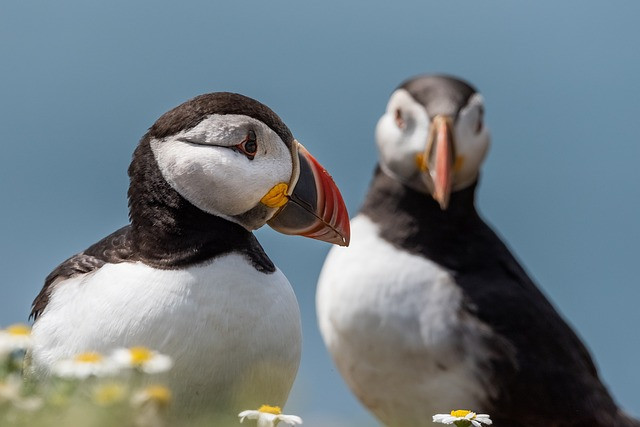
Introduction
Puffins are one of the most recognisable seabirds in the world, with their colourful striped beaks and stocky bodies. But did you know that the Atlantic puffin population declined by up to 80% in the 20th century? With threats from climate change and human activity, puffins need our help. This post will cover puffin basics, their life cycle, current conservation challenges, and their cultural significance.
Puffin Basics
Physical Characteristics
Puffins are stocky black and white seabirds about 10 inches tall. Their most striking feature is their massive, colourful beak which is striped with yellow, red and blue during breeding season. Their beaks turn dull grey in winter. Puffins have a round, puffy appearance from their thick white chest plumage. Their black wings and back help them blend in with dark ocean waves when seen from above. Compared to other seabirds, puffins have short wings suited for diving and swimming underwater.
Habitat
Puffins nest on grassy clifftops and rocky islands in northern coastal regions of the North Atlantic and North Pacific oceans. Some key puffin colonies are found in Iceland, Norway, Greenland, Newfoundland, Maine, Scotland and Japan. Puffins spend most of their lives far out to sea when not breeding, so they can be found flying and swimming across vast stretches of ocean.
Diet
Puffins primarily feed on small fish like herring, sand eels and capelin. They also eat plankton, squid and crustaceans. Puffins catch fish by diving from the surface and using their wings to “fly” underwater. Their wide, hinged beak can hold dozens of fish at a time. Puffins return to land each breeding season to feed their chicks.
The Life of a Puffin
Mating and Breeding
Starting in April, puffins return from sea and gather in large colonies for the breeding season. Courtship rituals include billing (rubbing beaks), circle dances and beak waving displays. Puffins nest in underground burrows on grassy clifftops or earthen mounds. The female lays a single white egg which both parents take turns incubating for about 40 days.
Parental Care
Puffin parents share chick rearing duties equally. They take turns incubating the egg, defending the nest and catching fish to bring back to feed the chick. The chick stays in the burrow while both parents continuously deliver small fish for it to eat. Once the chick fledges at around 6 weeks old, the parents abandon it, leaving just before it flies off to sea.
Migration Patterns
By August, puffins leave their breeding colonies and head back out to sea for the winter. Some populations stay in cold northern waters while others migrate down to more temperate regions. Come spring, mature puffins return to the same breeding colony and often even reuse the same burrow if available.
Conservation Status
Current Threats
Due to overhunting and harvesting of puffin eggs in past centuries, puffin numbers dwindled dangerously low. Today, puffins face threats from climate change, ocean pollution, disturbance of nesting colonies and lack of food from overfishing. Their nesting habitats are also threatened by invasive plant species.
Conservation Efforts
Protecting and expanding suitable nesting habitat is a key conservation goal. Eradicating invasive species, prohibiting development near colonies and limiting human disturbance helps protect populations. Sustainable fishing practices can ensure the fish stocks puffins rely on. Volunteers help monitor populations and hand-rear chicks in some endangered colonies.
Cultural and Symbolic Significance
Puffins appear in Norse mythology and Celtic folklore, where they were considered mystical birds. Their clownish appearance but aerial agility inspired many stories. In Iceland and coastal Maine, puffins are used extensively as symbols for schools, sports teams and local businesses. Puffin festivals are held annually in Maine to celebrate this iconic bird.
Conclusion
With their colourful beaks, puffy chests and waddling walks, puffins are charismatic birds that have captured human imagination for centuries. They play an important role in northern coastal ecosystems. Ensuring sustainable fish stocks and protecting their breeding grounds will give puffins a fighting chance to survive mounting environmental pressures. Their future depends on greater environmental awareness and conservation commitment from governments and individuals alike.
Call to Action
Puffins need our help now more than ever. Here are some ways you can get involved and make a real difference:
- Donate to puffin conservation charities to support habitat protection, research, and conservation efforts. Even a small donation goes a long way.
- Volunteer with local puffin monitoring projects. Help survey populations, collect data, and raise awareness.
- Contact your local MP or MEP and urge them to support sustainable fishing quotas and marine conservation legislation. Policies to protect oceans and fish stocks are key to puffin survival.
- Reduce plastic usage and participate in beach clean-ups. Ocean plastic pollution threatens seabirds like puffins.
- Practice responsible ecotourism by keeping a respectful distance from wildlife and staying on marked paths in nesting areas. Follow all regulations when visiting puffin breeding sites.
- Spread awareness on social media by sharing puffin facts, conservation concerns, and ways to help. Educate others about these special seabirds.
Puffins captivate us with their colourful charm and aquatic agility. But they need our advocacy to overcome the environmental challenges they face. With dedication and care from individuals like you, we can secure a future for puffins to thrive back on the waves where they belong.